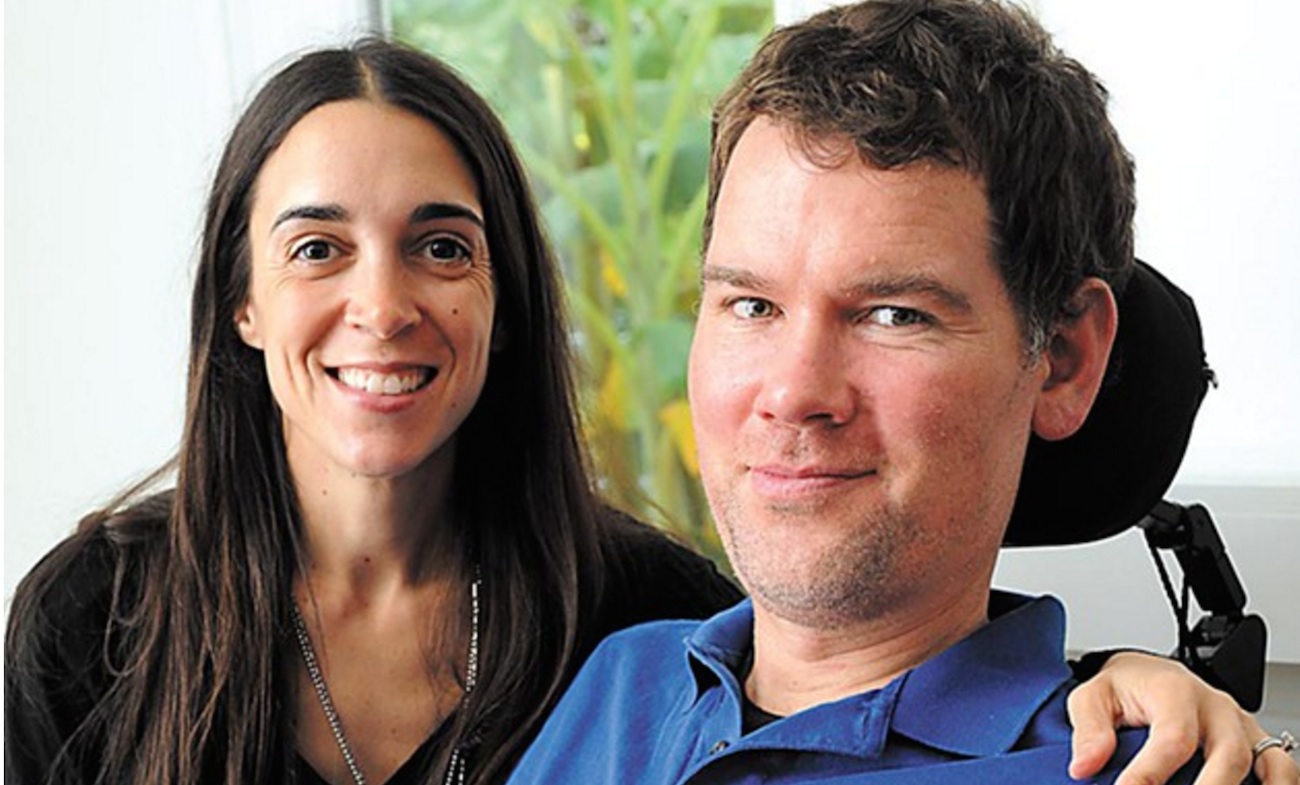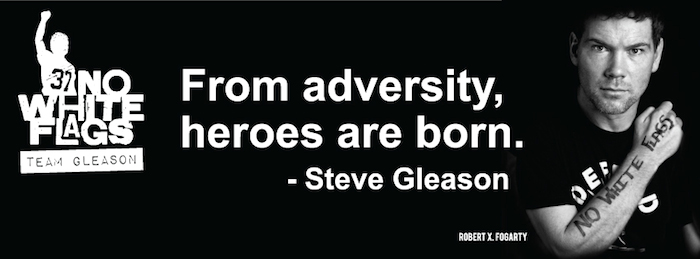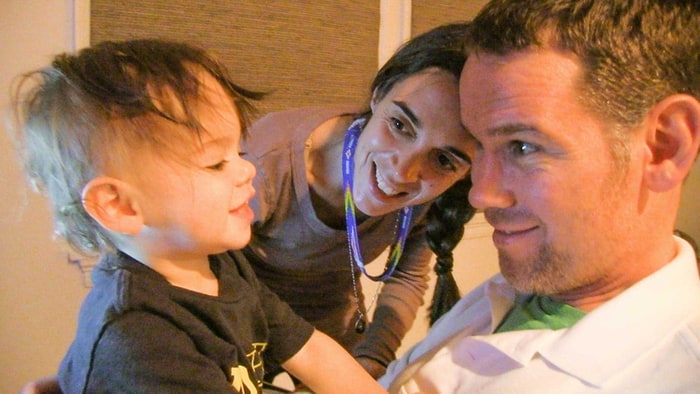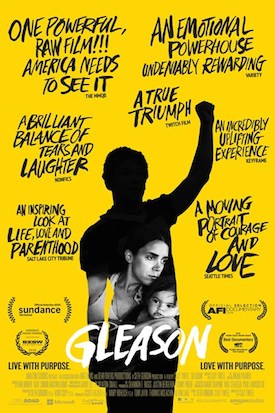 At the age of 34, Steve Gleason, a former NFL defensive back for the New Orleans Saints, was diagnosed with the devastating neurological disorder ALS (Amyotrophic Lateral Sclerosis sometimes referred to “Lou Gehrig’s disease”) and given a life expectancy of two to five years. Weeks later, Steve and his wife, Michel Varisco, discovered that Michel was pregnant with their first child. Director Clay Tweel’s inspiring doc Gleason masterfully assembles four years of footage of Steve and Michel, including personal video journals shot by Gleason himself for his then-unborn son Rivers, and the athlete’s globe-trotting adventures undertaken as part of his mission to live his life to the fullest. What emerges from this documentary is not only an astonishing portrait of the human spirit, but also an inspirational look at life, love, and family, and the intense bonds between husbands and wives and fathers and sons. Gleason premiered to standing ovations at the 2016 Sundance Film Festival and won an audience award at the SXSW Film Festival. I sat down with director Clay Tweel and Steve Gleason’s wife, Michel Varisco, to discuss this powerful film.
At the age of 34, Steve Gleason, a former NFL defensive back for the New Orleans Saints, was diagnosed with the devastating neurological disorder ALS (Amyotrophic Lateral Sclerosis sometimes referred to “Lou Gehrig’s disease”) and given a life expectancy of two to five years. Weeks later, Steve and his wife, Michel Varisco, discovered that Michel was pregnant with their first child. Director Clay Tweel’s inspiring doc Gleason masterfully assembles four years of footage of Steve and Michel, including personal video journals shot by Gleason himself for his then-unborn son Rivers, and the athlete’s globe-trotting adventures undertaken as part of his mission to live his life to the fullest. What emerges from this documentary is not only an astonishing portrait of the human spirit, but also an inspirational look at life, love, and family, and the intense bonds between husbands and wives and fathers and sons. Gleason premiered to standing ovations at the 2016 Sundance Film Festival and won an audience award at the SXSW Film Festival. I sat down with director Clay Tweel and Steve Gleason’s wife, Michel Varisco, to discuss this powerful film.
Danny Miller: At what point was the decision made to turn the video journals Steve was making for his unborn son into a feature-length documentary?
 Clay Tweel: After getting his diagnosis and finding out that Michel was pregnant, Steve didn’t know what the future would hold for him. He was thinking about ways that he could relate to his son and started doing these video journals. The idea for the film came out of that pretty quickly once Steve realized how cathartic it was for him to share his thoughts and feelings about what he was going through.
Clay Tweel: After getting his diagnosis and finding out that Michel was pregnant, Steve didn’t know what the future would hold for him. He was thinking about ways that he could relate to his son and started doing these video journals. The idea for the film came out of that pretty quickly once Steve realized how cathartic it was for him to share his thoughts and feelings about what he was going through.
Michel, you don’t seem like the kind of person who would normally want to put your personal life out there for all to see. Were you reluctant at first to participate in the documentary?
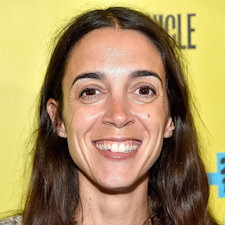 Michel Varisco: In the beginning, I had no idea it would turn into what it did, I thought that it was just a project Steve was doing to capture his life for our unborn son. We kind of dove into documenting Steve’s story instead of focusing on the bad parts of the reality we were facing. At first, we had so much fun going on all of these adventures after his diagnosis, there was a real lightheartedness to it. Steve was losing abilities but we were filming and doing so much and it was almost easier to deal with those losses with all that activity going on. We just stepped on this train and kept on moving.
Michel Varisco: In the beginning, I had no idea it would turn into what it did, I thought that it was just a project Steve was doing to capture his life for our unborn son. We kind of dove into documenting Steve’s story instead of focusing on the bad parts of the reality we were facing. At first, we had so much fun going on all of these adventures after his diagnosis, there was a real lightheartedness to it. Steve was losing abilities but we were filming and doing so much and it was almost easier to deal with those losses with all that activity going on. We just stepped on this train and kept on moving.
So you didn’t think at the time that strangers would ever be watching this footage?
Not even one percent of me thought that! If I had, I would have changed my outfits, I would never have walked around the house in Steve’s underwear, I would have bathed more, and I would have told the filmmakers to shoot me at better angles. (Laughs.)
In addition to the humor and the uplifting moments, I think the real power of the film is the willingness you both had to show the extremely difficult and painful moments. It was courageous of you to let Clay include that scene where you’re in bed talking to Steve in a monotone and clearly not in a good place. Did you ever consider asking him to take that out of the film?
You know, that was a scene that we did talk about taking out because it was so intensely intimate and personal but from the beginning Steve said that he wanted this movie to be as real and raw as possible and to show the actual real-life brutalities of this disease — not on just himself but on everyone involved. To me, that scene is as real as it gets. I could have asked Clay to take it out because of my fear that I’d look bad since I wasn’t being patient with Steve but that’s how I felt at that moment, that was my reality. So we left it in and the truth is that many people have come up to talk to me about that scene and how they could relate to it in their own situations. It’s really hard for me to watch but it shows a kind of reality that you don’t usually get in movies like this.
Seeing the vulnerabilities of both of you only made me empathize and admire you more.
Clay: It’s a very dense scene because there’s just as much said in the silences than in what’s being spoken. For me it was very important because it helps to portray a lot of the complexities of the emotional side of caregiving. That you can feel all of these emotions in your brain at once and the overall effect is that you’re just exhausted.
Michel: I’ve found that the parts of the movie that make me cringe the most are some of the best parts. There’s also a scene in the bathroom between Steve and me that is hard to watch but I don’t remember ever seeing something so real in a movie.
I assume you had the right to ask Clay to stop filming if it ever became too much?
I only remember saying that one time during the whole process. Steve and I were having an argument and I had just had enough.
Clay: And that was already four years in!
Michel: Right. The only other time I ever said anything was when I was giving birth to Rivers and I said our cameraman could set the camera up for the delivery but couldn’t stay in the room. If I remember correctly, I think my words were, “Sorry…but fuck no!” I just didn’t think a 23-year-old kid should be in there watching me give birth. It was like frickin’ National Geographic! (Laughs.)
Clay, I’m sure the editing process is difficult in any documentary, but I imagine it was especially hard with a film like this, trying to find that right balance of those painful moments as the disease took hold and the uplifting message of Steve and Michel’s journey through it.
Clay: We had around 1300 hours of footage that we had to get down to 110 minutes. But yes, that was the biggest challenge — we wanted to find that emotional balance that mirrored their daily lives that were full of highs and lows. We wanted to show the humor and the pain, and we didn’t want to make people feel like we were beating them up emotionally.
Michel: I think Steve and I watched four or five rough cuts of the film. Clay did such a great job of listening to Steve’s concerns while still staying true to the film he wanted to make. It wasn’t easy — there was lots of back and forth.
Clay: As a filmmaker you have a very large responsibility to your subjects — this whole movie is framed as a legacy that Steve is trying to leave for his son and for the world. I certainly didn’t want to exploit the emotions of the situation in any way. So yeah, I had a constant dialogue with Steve to make sure that he was comfortable with the film.
The scenes with Steve’s dad are incredibly moving, I get choked up just thinking about them including that agonizing scene with that faith healer and when Steve and his father are being painfully honest with each other.
The stuff with Steve’s dad was very important. One of the things we narrowed in on as we edited the film was that this is not only a father-son story for Steve and Rivers, it’s also an intergenerational story about fatherhood. We wanted to explore the idea that the way you’re trying to impart lessons to the next generation is directly affected by the previous generation. So the dynamics between Steve and his dad and whatever disagreements they had was a very important throughline for the film.
Michel: There are scenes in the film that I’m sure Steve’s dad is not comfortable with but he loves his son and he wanted the film to be real. And the resolution between them is completely real — Steve knows his dad loves him and wants the best for him.
Michel, I know the last thing you want is anyone calling you a “hero” for your role in all of this. As the film is seen by more and more people, do you worry about how people will see you?
Yeah, I certainly don’t want any kind of “hero worship.” I did what I did because I love Steve, there wasn’t any choice. But there also came a time when I kind of broke and couldn’t do it any longer in the same way. We now have a new team of caregivers who care for Steve as I try to put myself back together again. So no, I don’t want to be pictured as any kind of hero. I’m just a person trying to get healthy again and find my own way, I’m sure not perfect or a saint.
No one is, and again, I think showing the struggles as honestly as the triumphs is what makes this such a powerful, inspiring film for so many people.
Clay: I think the core message of the movie is about the power and resilience of the human spirit and how, no matter what tragedies are thrown at you in life, if you can keep putting one foot in front of the other, you will get through it.
It’s true, even if it’s not dealing with something like ALS which is such a heinous disease.
Michel: It really is a heinous disease. But since I’ve been going through this, I’ve been realizing how much pain every person has in different ways as they’re going through their lives.
The work that your organization Team Gleason has done to help other people with ALS is just amazing. I sobbed openly in the theater over that guy with ALS who you send on that trip to Italy.
I could watch that scene over and over! That was so special because it was something he wanted to do so badly with his son and and we were able to help make it happen. He is a really fantastic guy.
And the work you’ve done to make sure people with ALS can get the technology that helps them communicate with the outside world is just so incredible. How is Steve doing now? Is his condition the same as what we see at the end of the film?
He’s actually feeling better than he has in about a year and a half. The movie documents the process of him losing all of his physicalities. But now, after getting the trach and getting such great care, he’s pretty healthy. He’s sort of on cruise control now.
Does Rivers have any idea that his dad is different from other dads?
It’s all he knows. He knows his dad can’t do certain stuff but he’s also surrounded by men who he thinks of like brothers. He has enough male role models in his life to get all the physical stuff in and he gets so much out of his relationship with his dad.
Clay: One thing I love about their set-up in New Orleans is the sense of family and community they have built. There are people around all the time and you feel this really tight-knit familial community, it’s so great.
Michel, how hard is it for you to watch the film these days?
Michel: I’ve seen it many times but I can’t watch it anymore when we go to screenings. I always cry when I hear Steve talking at the beginning.

